
‘Focus on potential rather than past success’
McCann London’s Chief Strategy officer on curiosity, corporate jargon and creating culture

From online to offline, experiences are taking precedence over product. An engaging, unique experience can cement a brand as part of a consumer’s lifestyle rather than just a retail exercise.

Supposedly, retail is not a world you want to be operating in at the moment. You only have to walk down a UK high street to see shuttered storefronts and recognisable names closing their doors for good.
There are many explanations for this growing trend, difficulties across international politics and businesses being a particular culprit. But take a look at the retailers that have closed. What many of them seemed to lack was the ability, or at least desire, to innovate. To recognise what their customer was now looking for and to change accordingly. Cathy Sparks, Vice President of Nike’s global stores put it best when she said, "Traditional retail is going to struggle. At Nike what we talk a lot about is that retail is not dead, but boring retail is dead."
In 2020, more than 80% of US retail transactions will still happen in-store according to a report from McKinsey. In-store still matters; your consumer is just demanding more. A buying decision is now more complicated than ever and so customers are looking for different ways to interact with the brand. And what do they really want? Experience, experience, experience.
This new wave of retail is not about pop-ups but about brands that have decided to invest time, money and resource into a permanent store. Craig White, senior project director for King’s Cross and Coal Drops Yard said of the project: “It’s not about consumption – you can get that online – it’s about delighting people…All the brands here have raised their game and offered multi-purpose creative spaces.”
Many digital, online-first lifestyle brands are recognising the importance of having a physical presence, of providing their loyal fanbase with a tangible experience. They are taking designs from online shopping and blending them with the best bits of shopping in an actual store to create beautifully immersive, imaginative and unique brand worlds.
Although it may be difficult to determine ROI from an experience, it’s about playing the long game, hoping that brand engagement over time will lead to sales. Geometry recently unveiled an immersive space called the Flagship that will allow brands to experiment with, test and trial 15 different types of technology that can influence shopper behaviour and purchase decisions. The space has been designed to help create seamless digitally influenced, physical retail experiences.
The focus here is not on sales but rather on creating and maintaining a relationship with the consumer. By entering a physical manifestation of the brand, you are immersed in its culture, you become part of its community.
The high street may be changing but, from a consumer’s perspective that’s for the better. Brands need to ensure they’re staying unique, creating a community and above all else offering something that makes a consumer happily reach for their wallet.
Below we explore the brands willing to innovate, adapt and mould their retail spaces to suit our experience age.
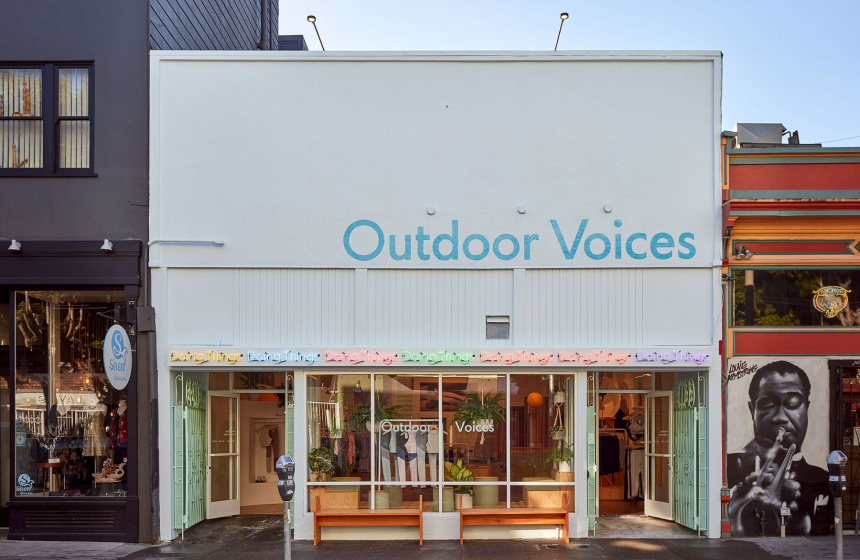
Outdoor Voices, San Francisco
Consumers align themselves with a brand because they believe the values mirror their own. But many also buy into the community created around that brand, especially if they’ve bought into the brand online. And sometimes even before they decide to invest in product.
And now, many of these digital-first, online brands are bringing their communities offline to meet consumers in person, making the physical space work harder. We’ve seen this most predominantly with Glossier, the beauty company recently valued at $1billion that frequently invites its online followers in-store to experience new products, take selfies and just generally feel like part of a very chic gang.
Outdoor Voices’ stores act as places for their millennial consumer base to gather. Every store hosts different events from hiking in LA to ‘dog jogs’ in Austin, making them hangouts. These events allow the consumer to participate offline whilst sharing their escapades online. The brand’s founder Ty Haney revealed in an interview with The New Yorker that many of their customers see the brand as a person: “Internally, we talk about OV as the hiking buddy who brought the snacks.” Haney also said one of her desires for the future of the brand is to connect with consumers before they’ve even made a purchase.
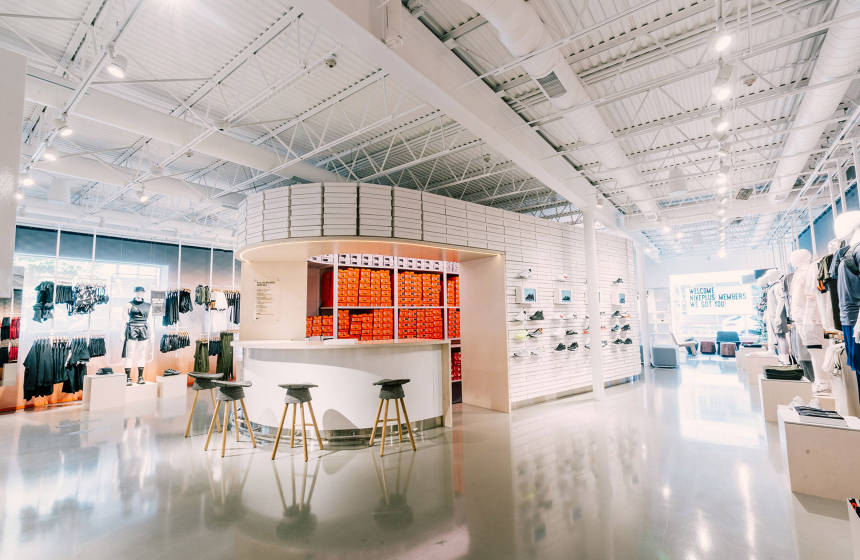
Nike by Melrose, Los Angeles
AI has been used to enhance the online shopping experience for many years. But now its use is migrating into offline stores. In-store AI allows brands to personalise shopping experiences, as well as having a more efficient store inventory. The algorithms can help identify key customers as technology records a person’s real-world shopping habits to ensure the information is linked to their online account.
Often this AI is enhanced by data gathered on a brand’s app, as is the case with Home Depot. Their app contains tools specifically designed to help a customer once they’re in a physical store. When it detects the user’s location, the app switches to in-store mode to offer real-time stock figures, precise product location details, detailed product information and relevant local offers.
Similarly, Nike trialled tech-driven shopping features at their Nike by Melrose store in Los Angeles – the first store in their Nike Live concept. The stock, and the store’s location, was decided on local consumers’ online shopping habits and users of the NikePlus app. The brand’s aim is to be able to predict what customers will buy and tailor stock accordingly. The space is designed for convenience with lockers allowing customers to pick up online orders, a Sneaker Bar and Curb Service. Nike plans to roll out these features in their stores around the world.
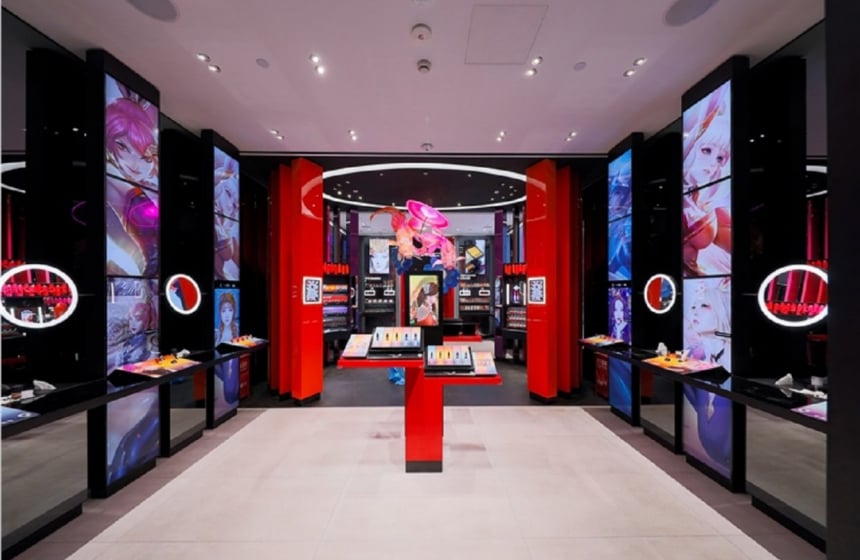
MAC Cosmetics Experience Centre, Shanghai
One of the greatest uses of in-store technology is to create a more personalised, tailored experience for the consumer. This is what consumers want; there’s no point settling for a one size fits all approach anymore. Retail applied technology helps create a seamless link between the on and offline experience.
Sephora and interactive experiential agency Wildbytes created and installed an intelligent digital mirror at the store’s flagship in Madrid. Powered by AI, it delivers hyper-personalised experiences and product recommendations bringing the depths of personalisation currently only available online into the physical store. The mirror can track gender, age, look and style, and generate appropriate recommendations. These are also informed by other factors including weather, season and top-trending items. Once a product is recommended, the mirror displays a QR code allowing the customer to either shop online or find the product on the shelf.
MAC Cosmetics in China worked with Wunderman Shanghai to create the MAC Cosmetics Experience Centre off the back of six months of research into Gen Z’s make-up purchase behaviour. Research included focus groups and exit interviews resulting in the technology that now sits at the heart of the store. When you walk into the store, you are invited to scan for a WeChat check-in. This then creates your own mini programme that becomes your passport for the whole store experience.
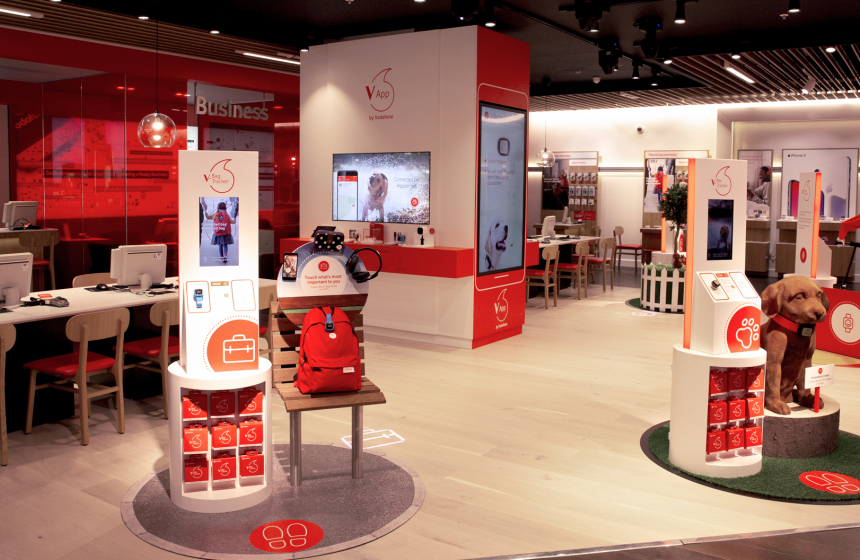
Vodafone, 'V by Vodafone' by Haygarth
For larger, more established retailers, change tends to happen more slowly. When a business, and sector, has operated in a certain way for years, innovation has to take a different form. For RPM, Three Mobile and the brand’s new store on Oxford Street, this meant getting rid of the bolted down phones that show you nothing about the product and the tech jargon that littered the walls. Instead they installed ‘passion pods’ and gaming areas, allowing customers to really get a feel for the product before deciding to buy.
Haygarth undertook a similar project with Vodafone at the brand’s store in Westfield White City. They created V by Vodafone, designing interactive PODs alongside digital content that allowed customers to discover new products. It was part educative tool, part immersive experience, and on opening day, the store saw a 7x lift in sales of key products.
Recognising the threats you’re facing as a retailer allows you to innovate accordingly, something that Boots recently announced they would be doing. Starting with 24 of its biggest beauty halls – Boots has just under 2,500 stores nationwide - the store will replace beauty counters with live demonstration areas, discovery and trending zones. The brand is hiring around 200 beauty specialists who will have received ‘immersive’ training as well as introducing 20 new brands in-store. Boots have also announced a yearlong partnership with Glamour magazine resulting in the brand’s sponsorship of five live beauty festivals across London and Manchester.
Traditionally, holiday companies have operated out of stores littered with garish posters and gigantic discounts. Now, with the rise of Instagram and influencer culture, customers can plan their own holidays with ease. Virgin Holidays recognised that to draw in customers, they needed to create something a little different. Working with Your Studio, the brand opened their largest and most-experience led store in Milton Keynes. Customers can relax in Premium and Upper Class seats with a glass of champagne or receive a complimentary manicure at the in-store spa. With a rollercoaster simulation, kids play area and bar, the store has been designed to appeal to travellers looking beyond a standard holiday.
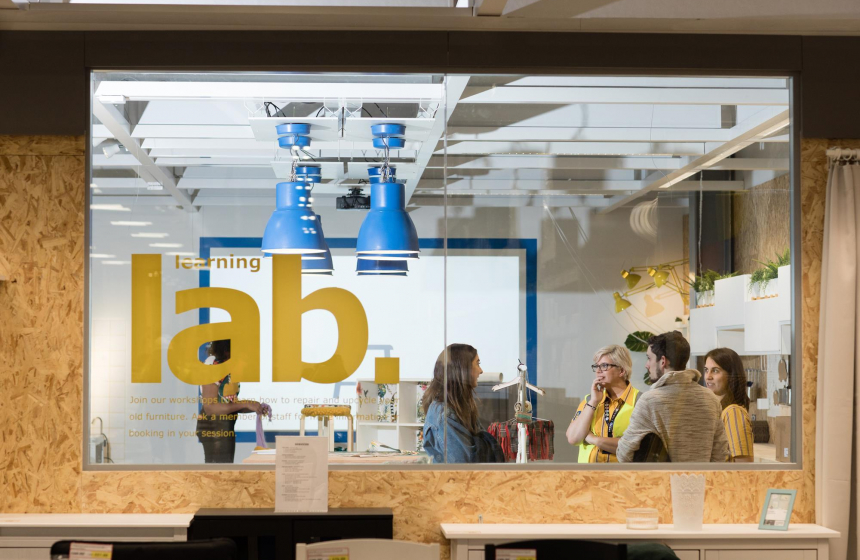
IKEA Learning Lab, Greenwich
“Modern retail is theatre,” so said Douglas Van Tress, co-owner of The Golden Triangle antique shops in Thailand. And what better theatre to show off your product in than the store you build yourself. Create the right experience and the product sells itself. Samsung’s new store in Coal Drops Yard has been described as a “creative and digital playground.” Working alongside Cheil, the store will bring the latest technology from the brand to life through curated experiences. The brand views the store as a showcase, demonstrating to consumers the ease, efficiency and convenience of the products on offer.
When Steve Jobs opened the first Apple store in 2001, he said the company’s job was to enrich lives, not sell computers. Today at Apple, launched by the technology company in 2017, brings the brand to life in 18,000 sessions a week around the world. The focus of these sessions is on enriching consumers’ lives with passionate creativity; the kind enhanced by Apple’s products and technology. Today at Apple demonstrates how we need to think about retail in the future, when it can serve a bigger purpose than just selling.
IKEA recently opened their “most sustainable store ever” in Greenwich, London. Featuring green spaces and a roof pavilion, there is also a Learning Lab where customers can participate in workshops around prolonging the life of products, upcycling and making their homes more sustainable. While the brand is championing sustainability in its design, aiming to achieve 100% renewable energy, it’s through the experiences and workshops they’re hosting that they want to inspire and enable their consumers to live a more sustainable life at home.
Alongside their stores, Lush also have several spas around the country. These sit independently as an immersive, luxury experience. Each treatment uses the products found in-store as well as creating bespoke soundtracks to accompany your experience. The spa’s ethos aligns with that of the brand, allowing the consumer to enjoy the product in a more natural and immersive setting.
Looks like you need to create a Creativebrief account to perform this action.
Create account Sign inLooks like you need to create a Creativebrief account to perform this action.
Create account Sign in